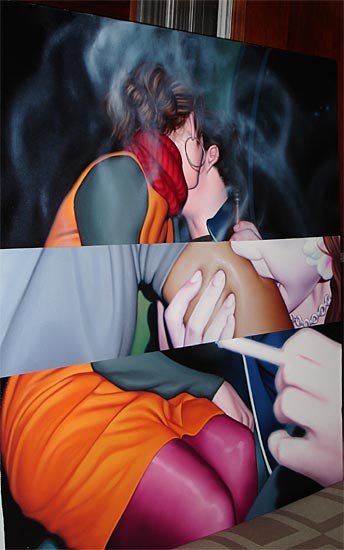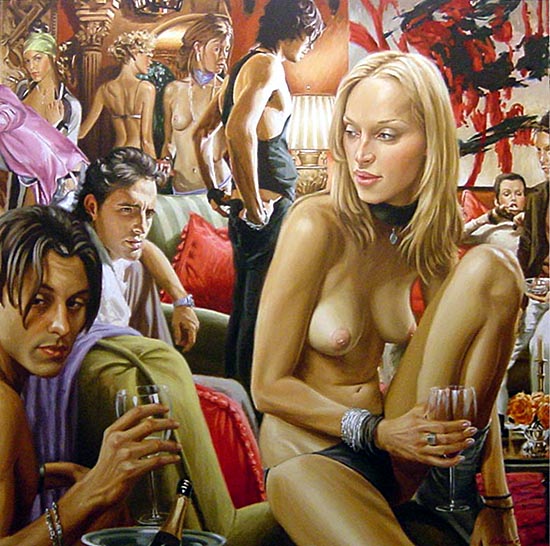New work by PAUL GALLOWAY.
"Love Will Tear Us Apart"

ARTIST'S STATEMENT:
My paintings depict young people at parties, bars, and private, intimate settings. I begin by taking digital photographs that are edited in Photoshop and printed. The subsequent physical act of pushing paint around canvas, romantic and intoxicating, allows me to act as an interpreter; I become an imperfect conduit through which color and form deviate subtly from their source. My paintings are close interpretations of photographs; a realistic plasticity of surface, mediated by my hand, is necessary to achieve the over-reality I want.
Like reality T.V. shows, the scenes I paint are so removed from and yet so close to reality that the experience becomes one wholly it's own. The bodies of young men and women sprawl across my large canvases, always on the verge of action or speech. Fields of color, pattern, and objects demand as much attention as the figures do. I want an overload of irrelevant information, not a clear delineation of my intent.
There are no faces; the anonymity of the characters is crucial to the artificiality I seek. In order for human drama to lose some touch with experiential reality, the specific identities of the characters involved are the first things to be jettisoned. The multiple panels function like comic book pages or channel surfing: different scenes relate to/ interact with each other creating a broken narrative and setting up nonsensical visual analogies. Hawaiian Lay is to Floral Print Blouse as Beer Bottle in Hand is to Hand Moving Closely to Crotch. The ability to construct clear narratives is hindered by my deletion of key facts most notably faces and by the visual noise caused by a glut of color, objects, and body parts.
Every step in the translation of an image alters it's content and, subsequently, our reception of the event. Every filter the image must pass through (including myself) becomes both barrier and mediator between the viewer and reality. An inverse relationship is created: the closer my paintings approach optical (or photographic) realism the further they get from experiential realism. This relationship creates contradiction on the canvas and for the viewer. How can a painting so culturally engaged and tactilely convincing feel so artificial? Because paint evidences my hand and my presence, the viewer must deal directly with me as mediator, regardless of how tactile the paint surface may seem. When my narratives enter this context human drama and experience become simultaneously more and less real. I believe contradictory statements are the most clear and purposeful a painting can make. Painting has the capacity to relate experience in an impossibly unique way it is for this reason I choose paint as the vehicle
for my stories.
Work in the Collection also includes a major piece by TERRY RODGERS.
"The Vortex"

Rodgers is concerned with our physical relationship to art. He creates a surreal uncertain world with everything in suspension. Figures are caught in mid–motion. There is a confluence of reality which is an aspect of the American dream. “The intrusion of reality is a discomfort that many of us carry with us,” says Rodgers. The paintings make us consider how many “worlds” we and the figures are caught “between”.
Rodgers is interested in the luminous details of the gestures that show the tension of communication. “Its all a matter of how light hits every surface, illuminating the moment of uncertainty,” he says. Rodgers invents interior design with their contrasting brocades, sheer metal surfaces, the clothes, the jewelry all points up the artifice of our lives. Artifice seems to mirror the people’s vitality and their sense of personal engagement.
Rodgers draws attention to the ways people listen or don’t listen to each other. “Each figure is delicately poised in relation to the others. You can sense their groping towards a solution.” This is stop-action painting where we focus on the intimacy and decisions of the moment. It is a private experience in a public place.. The paintings are existential vignettes within a veneer of refinement and restraint.
Rodgers work is part of the permanent collections of the Smithsonian Institution, Washington, D.C., U.S. House of Representatives Office Bldg, Washington, D.C.,.,Supreme Court of the State of Ohio, Science and Technology Committee Room, U.S. House of Representatives Office Bldg, Washington, D.C., Fannie Mae, Federal National Mortgage Association, Washington, D.C., Kennedy Institute of Bio-Ethics, Washington, D.C., among others.
ARTIST"S WEBSITE: http://www.terryrodgers.com
ARTIST'S STATEMENT:
My paintings are large, complex designs that attempt to reflect my sense of the times we are living in, and both how richly interesting they are and how difficult it is for most of us to navigate their uncharted waters. There is a great push and pull, the lure and the repulsion, the fiction and the real, the known and the unknown. And we live in this swirl of delicate gestures, driving desires, fantasy, economic complexity and interdependence, isolation and hope. I am trying to render some notion of this rich fabric.
Infinite fascination with details and dynamic pictorial architecture in combination with frustrated and sublimated desires make for a curious, static combustion in a painting. I attempt to map out these forces in western culture with a sense of their infinitely regenerative power.
And it's about the viewer—how we interpret and react to what we see, how we are the people in the paintings—and how they are us.
The paintings are not meant to judge or criticize. I am looking closely at who we are, the density of influences upon us, the mistakes we make, and the recognitions that occur in trying to navigate a universe with no sign posts. The figures in my paintings often are seen at a moment where some recognition or self-reflection seems to be taking place. These moments of recognition are metaphors for grappling with the unknown. Perhaps something is missing from their lives and they don't necessarily know what it is. They are metaphors for the search. My reaction to the figures and their gestures is sympathy, not judgment.
My hope is that ultimately these paintings show fragile, genuine human beings trying to make something of what they are confronted with. Each of them is unique in their individuality—in their hair, their eyes, their lips, their hands—and they are all separately struggling and often finding merely surface solutions and ephemeral escapes to the timeless riddles of consciousness.
NEW BOOK ABOUT TERRY'S WORK
"Love Will Tear Us Apart"

In the past few years, TERRY RODGERS has emerged as one of America’s most talented figurative painters. Thanks to a brilliant technique combining effortless brushstrokes and elaborate compositions, his paintings compel the viewer to participate in a disenchanted world where beauty, sex and money do not seem to bring happiness. In Rodgers’ world of appearances, the real wealth lies in the art of painting.
The Apotheosis of Pleasure, published by TORCH Books of Amsterdam, is the first comprehensive full-color catalogue to feature the work of this artist who will surely be recognized as on of the most important painters of the early 21st century. More than 60 works — selected in conjunction with the artist — present the full scope of Rodgers’ latest endeavour at portraying contemporary body politics. His rendering of the upper-class leisure life stands as an iconic vision of today’s society.
A short erotic tale, The Absent, by internationally best-selling French writer ALINA REYES (The Politics of love, The Butcher), invites the viewer to share a passionate and feminine experience of Rodgers’ work while also becoming the inspiration for performing our own story-telling based on Rodgers’ paintings.
In The Apotheosis of Pleasure, young and upcoming Belgian art critic CATHERINE SOMZÉ sets Rodgers’ work against the backdrop of cultural theories and establishes a possible archaeology of its iconography.
The catalogue is also available in a very limited special edition. Five specially designed boxes each include the book, a multiple signed by the artist and a special piece of lingerie by famous Dutch designer MARLIES DEKKERS.
The Apotheosis of Pleasure is a 112 page hardcover color catalogue of TERRY RODGERS’ paintings published by TORCH Books, Amsterdam (early December, 2006). The renowned Dutch design studio SMEL (http://www.smel.net) is responsible for the art direction and design of the book as well as the limited edition boxes.
The exhibition The Apotheosis of Pleasure is scheduled from 2 December 2006 until 13 January 2007 at TORCH Gallery. Address: Lauriergracht 94, 1016 RN Amsterdam,
phone: 0031(0)20-6260284.
